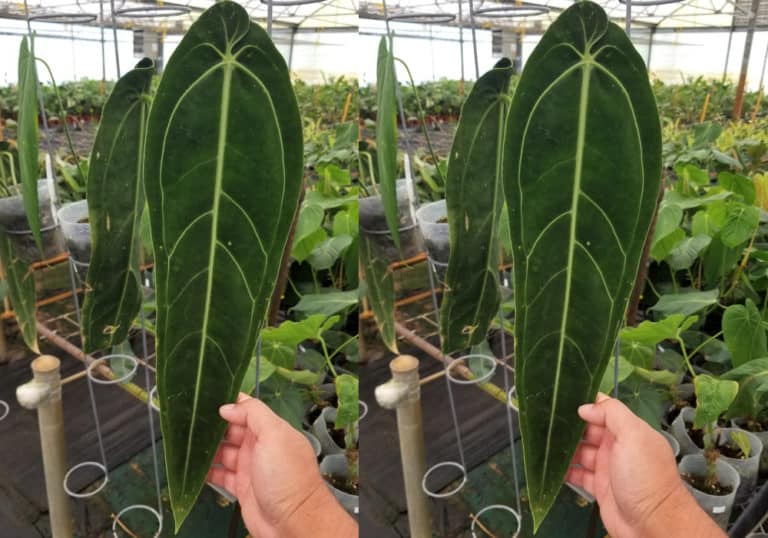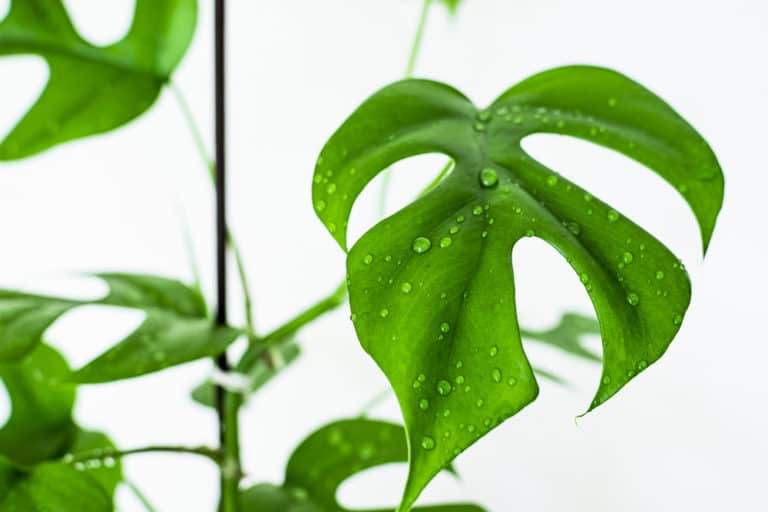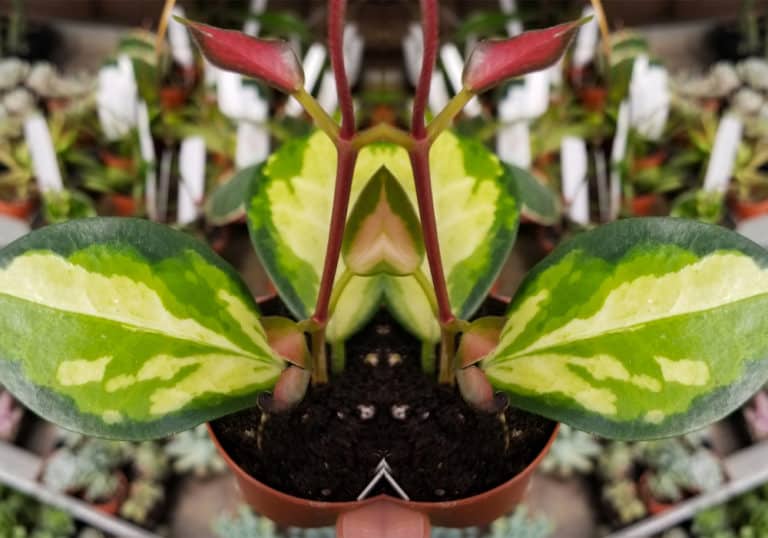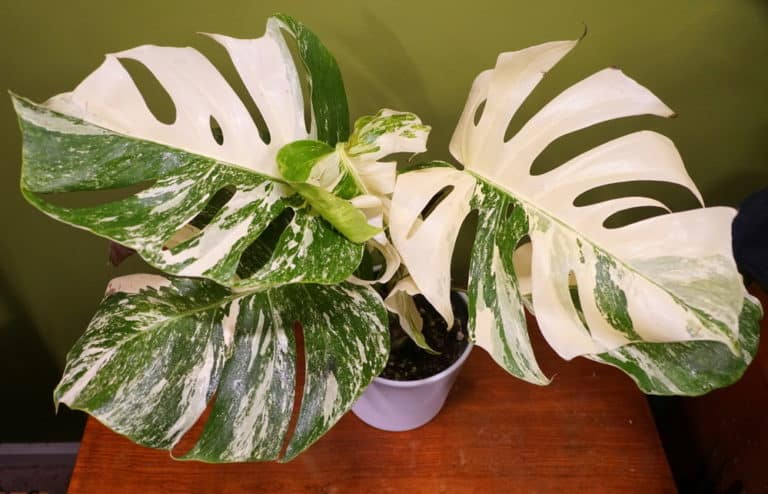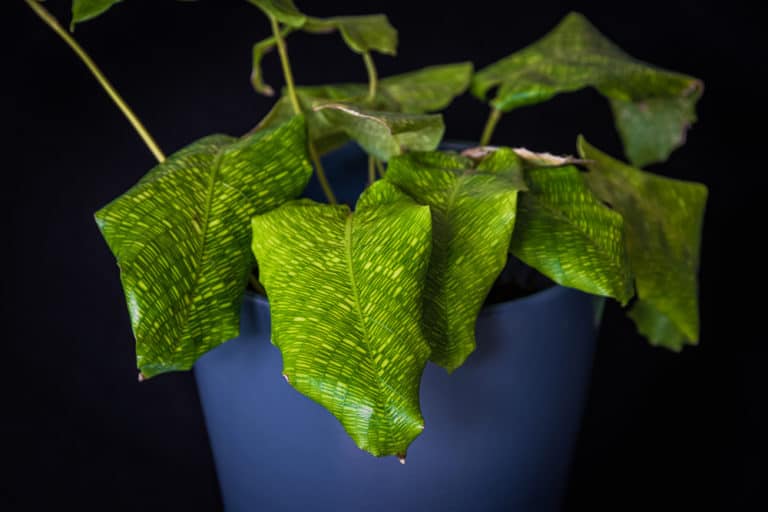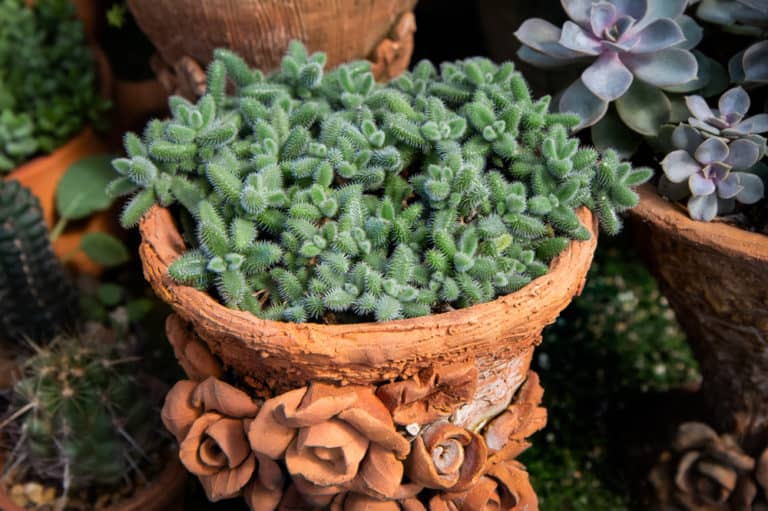Anthurium Veitchii ‘King Anthurium’ Care Guide (2024)

If you have ever visited any tropical gardens from the past, chances are, you may have come across the Anthurium veitchii, also known as ‘’King Anthurium”. With its broad oblong leaves, arrow-shaped edges, the overall dark-green corrugated texture, and a rather pale green venation, the plant is undeniably a head-turner!
| Scientific Name | Anthurium veitchii |
| Common Name | King Anthurium |
| Light | Medium to bright filtered light |
| Watering | Once or twice a week |
| Temperature | 59°F-79°F (15-26°C) |
| Hardiness Zone | USDA Hardiness Zone 10 to 11 |
| Humidity | >60 % |
| Soil Type | Airy soil mix |
| Soil pH | Acidic to slightly acidic (pH 5.0-5.5) |
| Fertilizing | A balanced fertilizer (NPK at 14-14-14) |
| Repotting | Done every few years when it has outgrown its current pot |
| Pruning | Once or twice a year |
| Propagation | Stem cuttings, Seeds, Division |
| Toxicity | Toxic to animals and humans |
| Mature Size | Can grow up to 2 ft. tall and the leaves up to 6 ft. long. |
| Bloom Time | Typically blooms every 3 months |
What’s Unique About Anthurium veitchii?
The Anthurium veitchii plant is an amusing epiphyte. It grows on other trees and may relatively survive even without a growing substrate. Named after a London plant collector who first introduced the species, John Veitch, the plant since then has been extensively cultured and made widely available.
The King anthurium is native to the rainforests of Columbia. It has a striking beauty – attributed to its large, rippled, green-colored leaves. The plant is typically found in below canopies and blooms under ideal conditions. However, the foliage alone is the main feature, making it a staple specimen indoors and in any type of garden.
Anthurium veitchii Care
The Anthurium veitchii plant care consists of a fairly humid environment, cool ambient temperature, and a bright filtered light. While there may be some complexes regarding the King anthurium care, the plant can actually tolerate a bit of neglect.
Below is some caring guides to help you become well-informed when it comes to growing Anthurium veitchii.
Light
As mentioned earlier, the plant typically thrives below canopies as they usually grow on other trees. Often reaching the top where they are subjected to lots of natural light filtered by treetops, other tree branches, and leaves
Hence, the Anthurium veitchii light requirements would be medium to bright filtered light. If they are grown outside, avoid full sun exposure and place them on a spot that receives a little bit of afternoon shade. Too much direct light can scorch the delicate leaves which in turn causes unpleasant deformation.
Pro tip: If growing Anthurium veitchii indoors, it is recommended to place them near an east-facing window, by which the king anthurium light needs are easily met.
Watering
Anthurium veitchii watering is typically done once a week. The type of soil you’re using plays a crucial role in water retention and frequency. A good rule of thumb is to regularly check the medium first and see if the top inch of the soil feels dry to the touch.
Water king anthurium once or twice a week, particularly during the growing season. If located in a humid environment, the watering needs may change and are often reduced. Similar to other houseplants, you should avoid overwatering which can lead to soggy soil and can later harm the delicate root system.
Temperature
A cooler ambient temperature is preferable for the plant to remain vibrant and healthy. The Anthurium veitchii temperature range with which the plant grows best is between 59°F-79°F(15-26°C).
The king anthurium thrives in USDA hardiness zone 10-11. The plant may be grown both indoors and outdoors as long as the appropriate temperature is maintained.
Note that the Anthurium veitchi does not have an efficient low-temperature tolerance and may not perform well at temperatures below 59°F (15°C), as this may lead to freezing injury.
In an average home, the temperature for king anthurium is relatively easy to attain, because it usually falls between 68 and 76°F (20 to 24°C).
Humidity
A humid environment favors optimum growth of king anthurium. Maintain the ideal humidity for king anthurium which is above 60 % and it will retain its healthy foliage. Taking into account the condition in most tropical rainforests from which the plant originates, the Anthurium veitchii humidity requirements can be easily attained by use of a humidifier, setting up of pebble tray, and grouping your plants together to improve air moisture.
However, the humidity level should not be too high as this can encourage the incidence of pests and diseases. It’s also important to maintain a good airflow so as not to oversaturate the leaves which may lead infection.
Soil
In their native habitat, the Anthurium veitchii soil may not be required as the plant tends to grow on other trees. However, with extensive cultivation and breeding, the plant has been a common specimen being used to adorn gardens and home spaces.
The ideal soil for king anthurium are similar to those of commerical aroid mixes. What you’re after is an airy soil mix incorporated with perlite and peat moss or orchid bark. You can also create a rich substrate by combining sphagnum moss, charcoal and garden soil.
Avoid clumpy soils as these easily becomes soggy, making the plant vulnerable to root. The optimal ph level for king anthurium is slightly acidic or from pH 5.0-5.5.
Fertilizer
Given their epiphytic nature, the Anthurium veitchii fertilizer needs are at minimal since they only acquire small amount of nutrients from air and debris of trees. However, several observation indicates that feeding the plant frequently with a balanced fertilizer will promote vigorous and healthy growth.
When applying fertlizer for king anthurium, use a balanced fertilizer ratio of water soluble ones such as NPK at 14-14-14, and 12-12-12. You can also take advantage of organic fertilizers like vermicast and biochar as they promise long-term benefits, as far as plant growth is concerned.
Pro tip: employ the method of fertigation where you water and fertilize the plant at the same time. Do not use cheap fertilizers as they tend to accumulate in the soil.
Potting & Repotting
The right potting mix should compensate for the airy substrate that’s organically rich and well-draining. When potting, choose a container with sufficient drainage holes or preferably an orchid basket, which has a texture that is quite similar to those of tree branches. Overtime, the roots may attach themselves to the woody basket.
Anthurium veitchii repotting are done roughly every three years when the plant can reach a maximum height of 6 feet. When repotting, choose a pot size twice the size of the orignal pot. Another indicator that repotting of king athurium must be done is when the roots are already beginning to peak in the current container.
Pruning
Anthurium veitchii pruning are usually done to remove spent and diseased foliages. As a structural maintenance, gardeners would often trim drooping and decaying stems. This a good practice to prevent the onset of any diseases such as bacterial and fungal infections.
It’s also important to note that king anthuriums have a slow growth habit and may take 2-3 months to develop a new leaf. So cutting king anthurium are only done when necessary and when there is sufficient leaf flushes than can readily compensate the removed plant parts. This will ensure that your plant will only use its energy to those parts that functions well.
Propagation
The Anthurium veitchii propagation commonly uses stem cuttings, seeds, and the slightly advanced method of tissue culture. Below are some ways to propagate king anthurium with great success:
Stem propagation, is considered one of the most viable means of propagating most anthuriums. This is done by cutting of a section of the stem which has at least 3-4 leaves. Later allowing it to root in water or directly be planted on the ground.
Another is through division, which is done by simply dividing two or more Anthurium veitchii plants, identifying the piece with much roots so they can easily establish. This is usually done in spring.
Also, make sure to check out our in-depth Anthurium warocqueanum plant care guide.
Common Problems of Anthurium veitchii
As a plant parent, it is relatively common to encounter some Anthurium veitchii problems. However, early detection often leads to an immediate and a more efficient response. Also, some problems with king anthrium are often due to improper management such as overwatering and inappropriate medium. These can damage the leaves and may lead to stunted growth.
Pests
Anthurium veitchii pests can be quite problematic, especially when the plants are grown outside. Some of the common insects that you may encounter are mealybugs, thrips, spider mites, and scale bugs. These insects will feed on the plant by sucking nutrients out of the leavs and stems causing to stunted growth and yellowing. Some may event create wounds that may become an entrypoint for bacterial and fungal infection.
If you suspect that the king anthurium plants are infested, you may observe and manually remove the insects with water. You can also use horticultural oils such as citronelle and neem oils to prevent recurrence.
Diseases
Some of the most common Anthurium veitchii diseases are Bacterial blight, which can cause symptoms such as yellowing and water-soaked lesions. Another is the Bacterial wilt, caused by Ralstonia solanacearum, causing chlorosis and bacterial ooze.
Note that some diseases of king anthurium are aggravated by improper growing practices such as use of clayey soil, overfertilizing, use of unsanitized equipment when pruning or propagating, and overwatering.
When there is an infection, be sure to immediately remove the infected plant parts and observe a strict sanitation program. Use a disease-free planting material and apply disinfectants from time to time. Remember that bacteria can easily spread from soil, water, and propagules.
Growing Problems
Some of the growing problems of king anthurium are attributed to the cultural management practices employed. For example, it is crucial that the humidity level of 60 % is maintained so that new flushes and leaves will fully emerge without damage. This will also prevent the occurence of pests that may feed on the plant.
If you’re already dealing with a sick plant, it’s important to investigate first the causes of symptoms such as yellowing, wilting, and necrosis. See if it may have something to do with overwatering, underwatering, nutrient deficiency, temperature, the type of substrate used, and presence of feeding insects.
Toxicity of Anthurium veitchii
While the king anthurium may appear harmless, it’s important to note that this beaut has some degree of toxicity. Similar to most aroids, the Anthurium veitchii contains calcium oxalate crystals that are toxic to both human and animals.
So keep the plant away from small chillren and your furry friends as possible. Choose an elevated spot where it will be out of reach. If any plant parts have been ingested, symptoms that may appear includes ulcer of the oral cavity, pain in the abdomen, difficulty in swallowing and breathing. If any of these symptoms are present, seek immediate medical attention.
For Humans
The king anthurium contains calcium oxalate crystals and if ingested may elicit adverse reactions to humans. Small children are the most vulnerable so it’s important to place the plant on a position that’s out of their reach, such as on window sills, corner tables. You may also switch to hanging baskets as the plant tend to develop and expand its leaves.
As mentioned, the symptoms that may appear are swollen lips, irritation of the mouth and skin, difficulty swallowing, and disrupted breathing. If a person shows any of these symptoms following contact with the plant, immediately seek for medical help.
For Pets
Pets like to nibble on things and they can also chew on houseplants within their reach. Calcium oxalate crystals found in anthuriums are also toxic to pets. Dogs, for example may show clinical signs such as frequent and painful urination, blood in their urine and stool, pawing at face due to oral pain, and even vomiting – depending on the amount taken.
If you suspect that an animal have ingested the plant and there are signs of restlessness and irritation, give a call for pet poisoning helpline. Remove the plant and place them on a strategic location away from your furry friends.
Anthurium veitchii Appearance
Belonging to the plant family, Araceae, the Anthurium veitchii appearance consists of large and somewhat corrugated leaves that can spread up to 6 ft. tall. The leaves appear to have pleated blades that reflect light at an angle. Over time, the plant develops an arrow-shaped inflorescence that’s made up green spathe and cream to pinkish colored spadix.
Foliage
The most distinguishing feature of the foliage of Anthurium veitchii are its thick and spreading habit. It’s deep green color and pendulous formation makes it a stunning specimen for both indoors and outdoor gardens.
Each leaf features a pleated blade that reflects light at the right angle, making it shiny in appearance. The corrugated leaves can grow up to 6 ft. or 2 meters long. Perhaps this characteristic is an adaptation to expand their leaves in order to receive more light. This is because the plant is a known epiphyte and would usually grow in below canopies in their natural habitat.
Flowering
Anthurium veitchii flowering usually occurs at 3 months interval. It’s unique inflorescence forms like an arrow and features an off white to pinkish spadix. The texture of the flower spike is leathery and greenish to pale-white.
The king anthurium flower is enclosed in a spathe or a lanced-shaped bract which are actually modified leaf whose function is to provide protection for the spadix. Each of the flower’s glossy appearance may last for a few months.
If the plant is not blooming even if it appears healthy, there may be several factors causing flowers not to develop. These factors include lighting, fertilizer use, watering, temperature and humidity.
Size and Growth
The size of Anthurium veitchii is determined by its huge leaves that can grow up to 2 meters long. The height of the plant can go from 1 to 1.5 meter tall. Its growth rate is relatively slow and would only form new leaf every 3 months.
This subtle change in height makes the king anthurium ideal for container gardens, hanging baskets, and terracotta containers. If bought from a local plant shop, expect the plant to come in small size and a basket. As an aftercare, the plant may be later on transplanted to a much bigger container to accommodate its size.
Anthurium veitchii Fragrance
The scent of a plant is said to be a powerful tool in attracting insects for pollination. However, there is no clearly defined Anthurium veitchii fragrance or smell. A report indicate that most anthurium scents can go from sweet, similar to that of mangoes and berries, or stinky – like that of a shoe or rotten meat.
Anthurium smell can be subjective and is too subtle to even be perceived by human nose. As mentioned, the scent that the plant emits in their wild habitat can have differing functions, such as attracting pollinators or as a defense mechanism against feeding herbivores. However, some smell may signal the occurrence of a disease, so make it a habit to regularly check on your plant.
Suggested Uses for Anthurium veitchii
When grown indoors, the Anthurium veitchii proves to be a stunning houseplant and a perfect hanging specimen because of its leaves that elegantly flows downward. However, the king athurium can also be a magnificent display in any type of gardens. In some occasions, the spathes, which contains the flowers, are sold as cutflowers.
Aside from the plant’s aesthetic value, the king anthurium are also known to purify air and are effective in removing toxins and pollutants such as ammonia, formaldehyde, and xylene. Due to this attribute, the plant is typically placed in the kitchen, bathroom, living areas, and even bedroom.
Anthurium veitchii Varieties
There are more than a thousand species accounted for the genus Anthurium veitchii and so many varieties have saturated the market and you’ll be overwhelmed to get a glimpse of how they differ from one another. While there are no official types of king anthurium, there are several species that you can also tend to and grow.
Note as well that most of these plants are easy to care for and are capable of frequent bloom. So let’s take a look at a few of these specimen and their unique beauty that are as intriguing as the king anthurium!
Anthurium amnicola ‘White Lady’
The Anthurium ‘White Lady’ is a notable cut-foliage and a potted-plant selection coming from several crosses of other species of Anthurium. The plant posses an attractive foliage and elegant white flowers.
Anthurium radicans
The Anthurium Radicans is a creeping plant that features deeply grooved leaves with fascinating texture. A commonly collected type, the plant thrives with medium light and humidity level of 60 to 80 %.
Anthurium hookeri
This type of anthurium is perfect for any tropical inspired garden. The plant boasts an elongated, dark-green leaves that can spread up to 2 ft. long.This epiphytic plant thrives with sufficient light and ample space.
Anthurium coriaceum
The Anthurium coriaceum features a subtle pattern on its dark-green, paddle-shaped set of foliage – having a distinct center vein. Each of the blades can grow from 2 to 4 ft. long.
Anthurium decipiens
The Anthurium decipiens is a remarkable aroid with vast, deep-green ruffled leaves – having a defined textured and elongated petioles. The plant thrives in warm conditions and would also grow favorably in well-draining substrate.
FAQ
What is Anthurium veitchii?
Anthurium veitchii is an epiphytic plant with large, rippled, oblong-shaped and green-colored leaves. The plant is native to the rainforests of Colombia and has been extensively grown worldwide.
How to identify Anthurium veitchii?
The plant features a deep green leaves that are corrugated and oblong in shape. It also has pale green venation and a flower that blooms every three months.
How to care for Anthurium veitchii?
Provide the plant with a humid environment, cool ambient temperature, and a bright filtered light. Feed with a balanced fertilizer and remove spent foliages to retain vibrance.
How to grow Anthurium veitchii indoors?
Grow your Anthurium veitchii indoor by maintaining the temperature of 59°F-79°F, a humidity level of >60 %, providing lots of bright filtered light, and by watering as needed.
How to grow Anthurium veitchii outdoors?
Grow your king anthurium plants outdoor on a spot that receives indirect bright light and afternoon shade. Fertilize during the growing season and water only as needed.
How fast does Anthurium veitchii grow?
The king anthurium has a relatively slow growth rate. It is reported to develop leaves from new flushes only after a few months under ideal conditions.
How tall does Anthurium veitchii grow?
Even with an average size of just about 1 to 2 ft., the Anthurium veitchii can grow its leaves to 6 ft. long – especially when given proper care.
How to make Anthurium veitchii grow faster?
Water your Anthurium veitchii as often as possible during the growing season, but avoid soggy soil. Fertilize as needed and place on a bright spot.
How to stake Anthurium veitchii?
Give your king anthurium a small stake for support when it’s beginning to expand. Use a sturdy material and place near the center base of the plant.
How to pot Anthurium veitchii?
Choose a fair-sized pot to later accommodate growth. Fill the pot with half of the medium and place the plant on the center. Fill in the remaining soil.
How to revive Anthurium veitchii?
Provide the plant with adequate light and repot the plant if it has become root bound. Water only as needed and prune the spent flowers and foliages.
Why is my Anthurium veitchii dying?
If the plant is showing signs such as wilting and yellowing, investigate for pests or if the plant has been infected. Revitalize the plant by pruning the affected parts.
Why is my Anthurium veitchii drooping?
Drooping of the leaves may be caused by either overwatering and underwatering. Be sure to avoid soggy soils as this can affect the roots causing a droopy appearance.
How cold can Anthurium veitchii tolerate?
The Anthurium veitchi does not have an efficient low temperature tolerance and may not perform well at temperature below 59°F (15°C) as this can cause freezing injury.
How to get rid of pests on Anthurium veitchii?
To get rid of pests, use horticultural oils such as citronella and neem oil. Wiping the plant with a clean damp cloth can also keep pests at bay.
Is Anthurium veitchii toxic to cats?
Yes. The Anthurium veitchii contains calcium oxalate crystals which are toxic to cats. If ingested, can cause adverse reactions such as vomiting, diarrhea, and other form of irritation.
Is Anthurium veitchii toxic to dogs?
Yes. The king anthurium contains calcium oxalate crystals which are toxic to dogs. If ingested in huge amounts, these can cause vomiting, ulcers in the mouth, and restlessness.
Is Anthurium veitchii toxic to children?
Yes. The king anthurium plants have calcium oxalate crystals which are toxic to children. If ingested, these can cause vomiting, diarrhea, and other form of irritation.
Is Anthurium veitchii toxic to humans?
Yes. The Anthurium veitchii is toxic to humans because of the presence of calcium oxalate crystals that if ingested, can cause vomiting, diarrhea, and skin irritation.
Does Anthurium veitchii have a scent?
The king anthurium does not have a clearly defined smell. However, some reports indicate that the plant have subtle scents, but this may only function for pollination.

